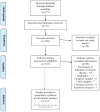A Systematic Review of Loneliness and Common Chronic Physical Conditions in Adults
- PMID: 26550060
- PMCID: PMC4636039
- DOI: 10.2174/1874350101508010113
A Systematic Review of Loneliness and Common Chronic Physical Conditions in Adults
Abstract
Loneliness is a prevalent and global problem for adult populations and has been linked to multiple chronic conditions in quantitative studies. This paper presents a systematic review of quantitative studies that examined the links between loneliness and common chronic conditions including: heart disease, hypertension, stroke, lung disease, and metabolic disorders. A comprehensive literature search process guided by the PRISMA statement led to the inclusion of 33 articles that measure loneliness in chronic illness populations. Loneliness is a significant biopsychosocial stressor that is prevalent in adults with heart disease, hypertension, stroke, and lung disease. The relationships among loneliness, obesity, and metabolic disorders are understudied but current research indicates that loneliness is associated with obesity and with psychological stress in obese persons. Limited interventions have demonstrated long-term effectiveness for reducing loneliness in adults with these same chronic conditions. Future longitudinal randomized trials that enhance knowledge of how diminishing loneliness can lead to improved health outcomes in persons with common chronic conditions would continue to build evidence to support the translation of findings to recommendations for clinical care.
Keywords: Chronic Condition; Loneliness; Systematic Review.
Conflict of interest statement
The authors confirm that this article content has no conflicts of interest.
Figures
References
-
- Theeke LA. Sociodemographic and health-related risks for loneliness and outcome differences by loneliness status in a sample of u.S. Older adults. Res Gerontol Nurs. 2010;3:113–25. - PubMed
-
- Steed L, Boldy D, Grenade L, Iredell H. The demographics of loneliness among older people in perth, western australia. Australas J Ageing. 2007;26:81–6.
-
- Portnoy E. Loneliness - a sourcebook of current theory, research and therapy - peplau, la, perlman, d. Gerontologist. 1983;23:329–30.
Grants and funding
LinkOut - more resources
Full Text Sources
Other Literature Sources

